#dum diversas and slavery
Explore tagged Tumblr posts
Text
SLAVERY & Dum Diversas (Africa, Asia, Oceania)
0 notes
Text
We grant you by these present documents, with our Apostolic Authority, full and free permission to invade, search out, capture, and subjugate the Saracens and pagans and any other unbelievers and enemies of Christ wherever they may be, as well as their kingdoms, duchies, counties, principalities, and other property and to reduce their persons into perpetual servitude.
Pope Nicholas V authorisation to Afonso V of Portugal
#quotes#religion#Corruption#death#Servitude#catholicism#fraud#slavery#Perpetual slavery#Dum Diversas#subjugation
5 notes
·
View notes
Text
#african/black experience#war on afrikans#terrorism#slavery#Dum Diversas-Doctrine of Discovery-1452/55 papal bull authorizing slavery#protest#racial profiling
0 notes
Text
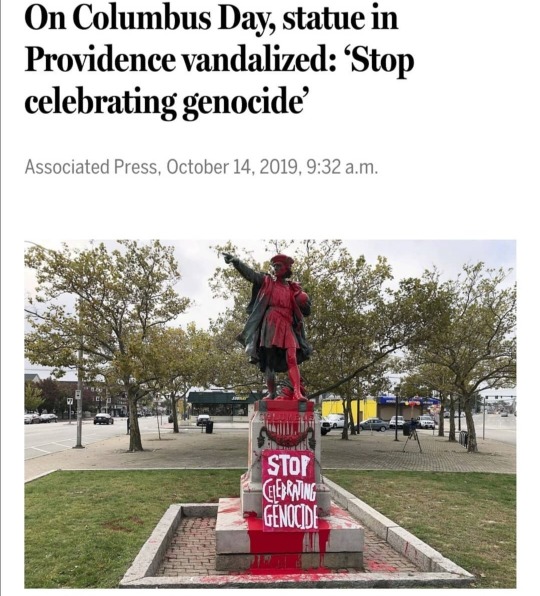
“Cancel culture” is nothing new, so why are we acting like it is? Those in power have written their own version of history as they’d like it to be remembered for ages. That “winners write history” is simply another way of saying that selective erasure (or canceling) of inconvenient truths is built into the fabric of documenting history.
What’s new is that now we’re looking backward to “uncancel” some of the important stories not widely shared about groups of people who have more power today than they’ve had in the past to record their truths for a broader audience.
An exemple is how has been washed, cleaned and packed up, the figure of Christopher Columbus in history books and mainstream european culture.
Some facts that you must know about Christopher Columbus:
- Christopher Columbus didn't discover America as a continent, and wasn't aslo the first European to visit American coasts: half a millennium before Columbus “discovered” America, Viking's feet may have been the first European ones to ever have touched North American soil. The expedition’s leader was Leif Eriksson (variations of his last name include Erickson, Ericson, Erikson, Ericsson and Eiriksson), son of Erik the Red, who founded the first European settlement of Greenland after being expelled from Iceland around A.D. 985 for killing a neighbor. (Erik the Red’s father, himself, had been banished from Norway for committing manslaughter.)
But Christopher Columbus was remarkably the first who came with the intention of a great military conquer.
- He didn't discover that the Earth is spherical: this knowledge was still accepted in the Middle Age and by the Christian doctrine.
Knowledge of the sphericity of the Earth survived into the medieval corpus of knowledge by direct transmission of the texts of Greek antiquity (Aristotle), and via authors such as Isidore of Seville and Beda Venerabilis.
Though the earliest written mention of a spherical Earth comes from ancient Greek sources, there is no account of how the sphericity of the Earth was discovered.
A recent study of medieval concepts of the sphericity of the Earth noted that since the eighth century, no cosmographer worthy of note has called into question the sphericity of the Earth.
Some examples are the papers of Pope Silvester II, who was awer of the knowledge of ancient greek philosophers and also of the researches of Muslim mathematicians. Also Saint Hildegard portrayed the Earth as a sphere in her Liber Divinorum Operum; Giovanni Sarabosco, an Italian astronomist wrote a paper (Tractatus de Spahaera) based on the knowledge of Ptolemy about the sphericity of the Earth; Honorius of Autun, a theologist very popular also in lay community,in his Elucidarium, a survey of Christian beliefs wrote about the sphericity of the Earth. His works was translated frequently into other languages.
Another proof that this knowledge was diffused also in the low folk and not only among the intellectuals of the Church, can be found in some of Berthold von Regensburg homelies in which he explained that the earth is spherical.
A practical demonstration of Earth's sphericity was achieved by Ferdinand Magellan and Juan Sebastián Elcano's expedition's circumnavigation (1519-1522).
- Christopher Columbus was the first European to have the idea to enslave native Americans and force them to work in colonizer's encomiendas. According to Cuneo, Columbus ordered 1,500 men and women seized, letting 400 go and condemning 500 to be sent to Spain, and another 600 to be enslaved by Spanish men remaining on the island. About 200 of the 500 sent to Spain died on the voyage, and were thrown by the Spanish into the Atlantic. (Bergreen, 196-197)
Those left behind were forced to search for gold in mines and work on plantations. Within 60 years after Columbus landed, only a few hundred of what may have been 250,000 Taino were left on their island.
- If you think that Christopher Columbus was loved and admired by people of his age, you are wrong: he gave land to the settlers and permitted the enslavement of the Taino people to work it. Complaints for his violence against Caribs and Taino Indians, but mostly for his cruelty against Spanish settler, trickled back to Spain, and eventually the monarchs sent a commissioner to investigate. Shocked by conditions at the colony, the commissioner arrested Columbus and his brothers and sent them back to Spain for trial. The brothers were released by the king and queen, but Columbus was removed from his position as governor of Hispaniola.
- Christopher Columbus was the fist European to commit a genocide: 56 years after Columbus's first voyage, only 500 out of 300,000 Indians remained on Hispaniola.
Population figures from 500 years ago are necessarily imprecise, but Bergreen estimates that there were about 300,000 inhabitants of Hispaniola in 1492. Between 1494 and 1496, 100,000 died, half due to mass suicide. In 1508, the population was down to 60,000. By 1548, it was estimated to be only 500.
Some important facts about slavery, Catholic Church and the famous Monarchs of Spain, Isabel of Castile and her husband Ferdinand of Aragon:
In 1492, Kingdom of Castile and Aragon had a disperate need of money: King Ferdinand and his wife Qeen Isabel used a lot of money in their wars against Portogual and their Conquer of the Emirate of Granada, that was an indipendente Muslim state at the age. They were deeply in debt, also with jews pawloaner, who at the age, were the only allowed to borrow money (Christian doctrine, by the way, didn't allow it), so they wrote the infamous Alhambra Decree with witch all jews were forced to left Spain and their properties passed in the Monarchs' hands.
I red some people associated the Dum Diversas with Columbus, but it has nothing to concern with "discovery" of the "new world": Dum Diversas is a papal bull issued on 18 June 1452 by Pope Nicholas V. It authorized Afonso V of Portugal to conquer Saracens and pagans and consign them to "perpetual servitude". It was referred to the muslim population of North Africa and also to the Turkish territories in Europe.
By the way, the Catholic Chruch condamed slavery in various occasion: in 1537 pope Paul III condemned "unjust" enslavement of non-Christians in Sublimus Dei. In 1686 the Holy Office limited the bull by decreeing that Africans enslaved by unjust wars should be freed. Eugene IV and Paul III did not hesitate to condemn the forced servitude of Blacks and Indians, in Sicut Dudum (1435) and in Sublimis Deus (1537). Their teaching was continued by Gregory XIV in 1591 and by Urban VIII in 1639. Except those formal condemn of slavery, the Church keep an ambiguous sentiment: the condamn was absolute, but most of the government of their age were built on slavery and keep allow their people to profit on slavery, for the reason that "indigenous" people were not Christians, they didn't have a soul, so they were like animals. The Holy See was unable to stop the trade, despite their good intentions.
The pontifical teaching was continued by the response of the Holy Office on March 20, 1686, under Innocent XI, and by the encyclical of Benedict XIV, Immensa Pastorum, on December 20, 1741. This work was followed by the efforts of Pius VII at the Congress of Vienna in 1815 to have the victors over Napoleon outlaw slavery. The 1839 Constitution In Supremo by Gregory XVI continued the antislavery teaching of his predecessors, and was in the same manner not accepted by many of those bishops, priests and laity for whom it was written.
#us history#american history#history#christopher columbus#columbus day#indigenous peoples day#indigenous peoples of the americas#indigenous people's day: bay area led the change#indigenous people&039;s day#kingdom of spain#colonial history#colonialism#vavuskapakage#cancel culture#slavery#genocide#crimes against humanity#leif erickson day#leif erikson
23 notes
·
View notes
Text
12th King of Portugal (3rd of the Aviz Dynasty), King Afonso V of Portugal, “The African”
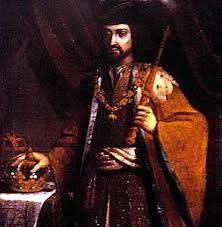
Reign: 13 September 1438 – 28 August 1481 Acclamation: 15 January 1446 Predecessor: Duarte I
Afonso V (15 January 1432 – 28 August 1481), known by the sobriquet the African (o Africano), was King of Portugal. His sobriquet refers to his conquests in Northern Africa.
As of 1471, Afonso V was the first king of Portugal to claim dominion over a plural "Kingdom of the Algarves", instead of the singular "Kingdom of the Algarve". Territories added to the Portuguese crown lands in North Africa during the 15th century came to be referred to as possessions of the Kingdom of the Algarve (now a region of southern Portugal), not the Kingdom of Portugal. The "Algarves" then were considered to be the southern Portuguese territories on both sides of the Strait of Gibraltar.

Afonso was born in Sintra, the second son of King Duarte of Portugal by his wife Leonor of Aragon. Following the death of his older brother, Infante João (1429-1433), Afonso acceded to the position of heir apparent and was made the first Prince of Portugal by his father, who sought to emulate the English Court's custom of a dynastic title that distinguished the heir apparent from the other children of the monarch. He was only six years old when he succeeded his father in 1438.
During his minority, Afonso V was placed under the regency of his mother in accordance with a will of his late father. As both a foreigner and a woman, the queen was not a popular choice for regent. Opposition rose and without any important ally among the Portuguese aristocracy other than Afonso, Count of Barcelos, the illegitimate half brother of King Duarte, the queen's position was untenable. In 1439, the Portuguese Cortes (assembly of the kingdom) decided to replace the queen with Pedro, Duke of Coimbra (Dom Pedro), the young king's oldest uncle.
Pedro's main policies were concerned with restricting the political power of the great noble houses and expanding the powers of the crown. The country prospered under his rule, but not peacefully, as his laws interfered with the ambition of powerful nobles. The count of Barcelos, a personal enemy of the Duke of Coimbra (despite being half-brothers) eventually became the king's favourite uncle and began a constant struggle for power. In 1442, the king made Afonso the first Duke of Braganza. With this title and its lands, he became the most powerful man in Portugal and one of the richest men in Europe. To secure his position as regent, Pedro had Afonso marry his daughter, Isabel of Coimbra, in 1445.
But on 9 June 1448, when the king came of age, Pedro had to surrender his power to Afonso V. The years of conspiracy by the Duke of Braganza finally came to a head. On 15 September of the same year, Afonso V nullified all the laws and edicts approved under the regency. In the following year, led by what were later discovered to be false accusations, Afonso declared Pedro a rebel and defeated his army in the Battle of Alfarrobeira,
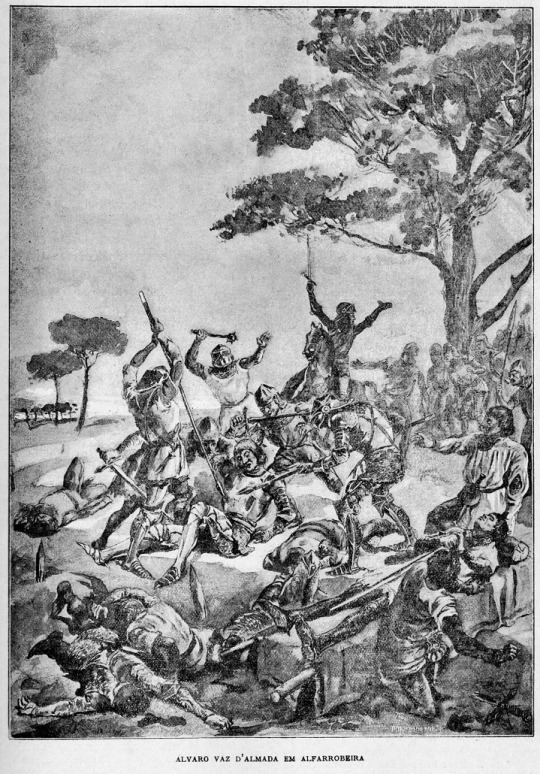
in which his uncle (and father-in-law) was killed. After this battle and the loss of one of Portugal's most remarkable infantes, the Duke of Bragança became the de facto ruler of the country.

Afonso V then turned his attentions to North Africa. In the reign of his grandfather João I, Ceuta had been conquered from the king of Morocco, and now the new king wanted to expand the conquests. The king's army conquered Alcácer Ceguer in 1458 and Arzila in 1471.
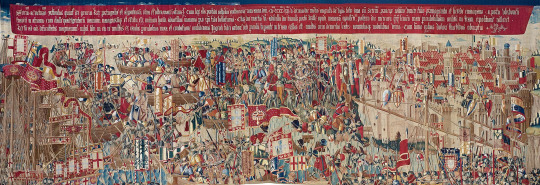
Tangiers, on the other hand, was won and lost several times between 1460 and 1464. These achievements granted the king the nickname of the African or Africano.
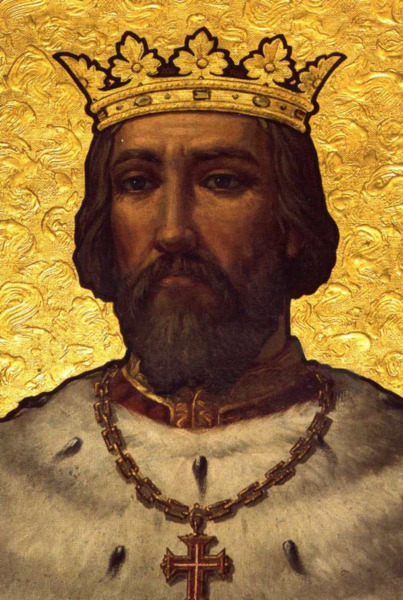
The king also supported the exploration of the Atlantic Ocean led by prince Henrique the Navigator but after Henrique's death in 1460, he did nothing to continue Henrique's work. Administratively, Afonso V was a passive king. He chose not to pursue the revision of laws or development of commerce, preferring instead to preserve the legacy of his father Duarte and grandfather João I.
In 1452, Pope Nicholas V issued the papal bull Dum Diversas, which granted Afonso V the right to reduce "Saracens, pagans and any other unbelievers" to hereditary slavery. This was reaffirmed and extended in the Romanus Pontifex bull of 1455 (also by Nicholas V). These papal bulls came to be seen by some as a justification for the subsequent era of slave trade and European colonialism.

When the campaigns in Africa were over, Afonso V found new grounds for battle in neighboring Castile. On December 11, 1474 King Henry IV of Castile
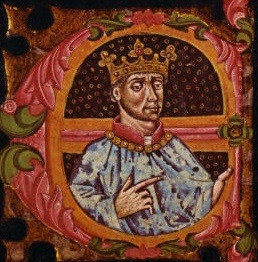
died without a male heir, leaving just one daughter, Joanna la Beltraneja.
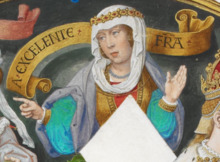
However, her paternity was questioned; it was rumored that his wife, Queen Joana of Portugal
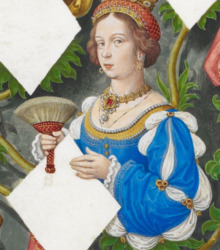
had an affair with a nobleman named Beltrán de La Cueva.
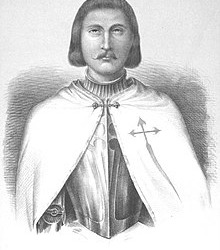
The death of Henry ignited a war of succession with one faction supporting Joana and the other supporting Isabel, Henry's half-sister.
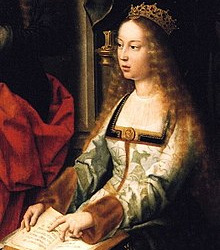
Afonso V was persuaded to intervene on behalf of Joana, his niece. He betrothed himself to her, proclaimed himself king of Castile and led troops into the kingdom. Because of their close blood-relationship, a formal marriage had to wait for papal dispensation.
On May 12, 1475, Afonso entered Castile with an army of 5,600 cavalry and 14,000 foot soldiers. In March, 1476, after several skirmishes and much maneuvering, the 8, 000 men of Afonso and Prince João,
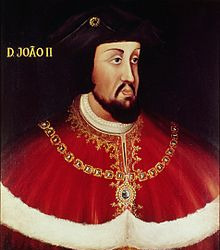
faced a Castilian force of similar size in the battle of Toro.
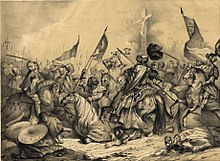
The Castilians were led by Isabella's husband, Prince Fernando II of Aragon
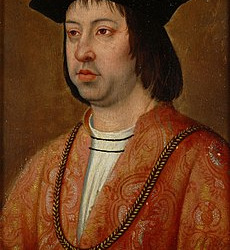
Cardinal Mendoza and the Duke of Alba. The fight was fierce and confusing but the result was a stalemate: While the forces of Cardinal Mendoza and the Duke of Alba won over their opponents led by the Portuguese King –who left the battlefield to take refuge in Castronuño, the troops commanded by Prince João defeated and persecuted the troops of the Castilian right wing, recovered the Portuguese royal standard, remaining ordered in the battlefield where they collected the fugitives of Afonso. Both sides claimed victory but Afonso's prospects for obtaining the Castilian crown were severely damaged.
“It was March 1, 1476. Eight thousand men for each side, the chronicles tell. With Afonso of Portugal were his son João and the bishops of Evora and Toledo. With Fernando of Aragón, Cardinal Mendoza and the Duke of Alba, as well as the militias of Zamora, Ciudad Rodrigo and Valladolid. The battle was long, but not especially bloody: it is estimated that the casualties of each side did not reach a thousand. Who won? In reality, no one: Afonso's wing of Portugal fell under the thrust of Fernando, but Prince João's troops crushed their Castilian rivals. However, victory in this battle was not going to be military, but ... political. In fact, Fernando of Aragon, seeing that the clash concluded without winners or losers, hastened to give his own version of the facts. He sent letters to all the cities of Castile and Aragon and to several European courts.”
After the battle, Afonso sailed to France hoping to obtain the assistance of King Louis XI

in his fight against Castile. But finding himself deceived by the French monarch, he returned to Portugal in 1477. Disillusioned, he abdicated for a few days in November 1477 in favor of his son João II, then after returning to the throne, he retired to a monastery in Sintra, where he died in 1481. He rests with his first wife Queen Isabel of Coimbra in the Founder’s Chapel, inside the Monastery of Batalha.
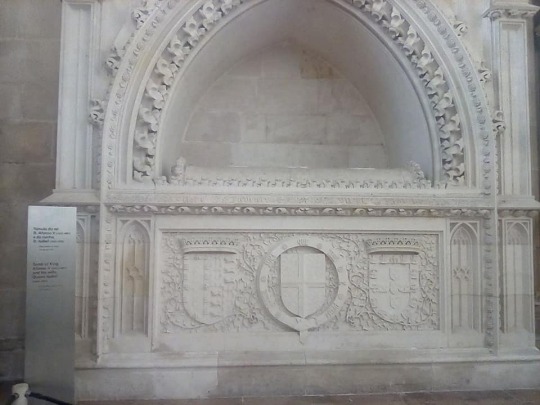
Afonso married firstly, in 1447, Isabel of Coimbra, with whom he had three children:
João, Prince of Portugal (29 January 1451). He his buried in the Unfinished Chapels in the Monastery of Batalha next to his grandparents King Duarte of Portugal and Queen Leonor de Aragão.

Joana, Princess of Portugal (6 February 1452 – 12 May 1490): Known as Saint Joana of Portugal or Saint Joana Princess.
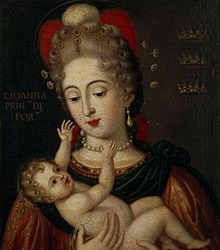
João II of Portugal (3 March 1455 – 25 October 1495): Succeeded his father as 13th King of Portugal.
Afonso married secondly, in 1475, his niece Joanna of Castile, known as "La Beltraneja".
7 notes
·
View notes
Text
the nexum debt-bondage system was analogous to indentured servitude, but slaves captured in war were absolutely chattel slaves. [link] i know there's some debate over this, but arguments that slaves captured in war by rome weren't in chattel slavery often seem to me to be biased in favor of defending rome. captured slaves were considered property, had no meaningful way of achieving freedom, and the children of slave women were born into slavery- that's the fundamentals of chattel slavery, and while it was different from the racialized forms of slavery that came later- as you pointed out slaves in rome were considered to be human in the technical sense- it wasn't that different- while they were considered technically human they did not have legal personhood, and it was legal for masters to kill their slaves for no reason in rome until 319 AD when Antoninus Pius illegalized it, and even after 319 AD it was still legal for romans to kill their slaves "with good reason".
it is true that many slaves were converted to serfs throughout much of europe, especially in the north, as the transition away from roman slave society and towards feudalism occurred, however, chattel slavery never really disappeared completely in medieval europe [link], especially not in southern europe, and for example in 1452 pope Nicholas V passed the Dum Diversas which gave christians in portugal to put any and all non-christians into perpetual slavery (in fairness that's on the tail end of the medieval era, but also that's not really the kind of edict you pass if slavery doesn't already exist in your society). the chattel slavery which would go on to form the triangle trade absolutely existed before capitalism, however, in fairness, it didn't really explode until the proto-capitalist transitional mercantilist stage.
i feel like there's a tendency to describe things that are liberal as fascist in a way that lets liberalism off the hook- as if genocide and segregation are exclusive to fascism, and as if liberal nations haven't engaged in genocide and segregation as well for as long as they've existed. if we posit that countries like the united states of america, israel, australia, etc are fascist and not liberal then the term liberal just doesn't mean anything. this also gives fascism too much credit-no nation built on fascist principles could last as long as any of the previously listed genocidal liberal nations. similarly, an individual can be bigoted, even genocidal, and still be a liberal.
3K notes
·
View notes
Photo






THE POPE, THE JEWS, AND THE SLAVE TRADE
Pope Nicholas V issued the Papal Bull Dum Diversas on 18 June, 1452. It authorised Alfonso V of Portugal to reduce any “Saracens (Muslims) and pagans and any other unbelievers” to perpetual slavery. This facilitated the Portuguese slave trade from West Africa.
The same pope wrote the bull Romanus Pontifex on January 5, 1455 to the same Alfonso. As a follow-up to the Dum diversas, it extended to the Catholic nations of Europe dominion over discovered lands during the Age of Discovery. Along with sanctifying the seizure of non-Christian lands, it encouraged the enslavement of native, non-Christian peoples in Africa and the New World.
In his book, Capitalism & Slavery, Eric Williams writes, “Portugal, which had initiated the movement of international expansion, claimed the new territories on the ground that they fell within the scope of a papal bull of 1455 authorizing her to to servitude all infidel peoples. The two Powers (Portugal and Spain), to avoid controversy, sought arbitration and, as Catholics, turned to the Pope – a natural and logical step in an age when the universal claims of the Papacy were still unchallenged by individual governments.
After carefully sifting the rival claims, the Pope issued in 1493 a series of papal bulls which established a line of demarcation between the two states: the East went to Portugal and the West to Spain… England, France, and even Holland, began to challenge the Iberian Axis and claim their place in the sun. The Negro, too, was to have his place, though he did not ask for it: it was the broiling sun of the sugar, tobacco and cotton plantations of the new world...”
See also:
- The Major Role the Catholic Church Played in Slavery
- Catholic Church and slavery
- Killings for Christianity
- The Birth of Race-Based Slavery
- CATHOLIC CHURCH CONDONED & PARTICIPATED IN SLAVERY
150 notes
·
View notes
Photo

@Regrann from @civilitary - Papal Bull Dum Diversas 18 June, 1452 Pope Nicholas V issued the papal bull Dum Diversas on 18 June, 1452. It authorised Alfonso V of Portugal to reduce any “Saracens (Muslims) and pagans and any other unbelievers” to perpetual slavery. This facilitated the Portuguese slave trade from West Africa. The same pope wrote the bull Romanus Pontifex on January 5, 1455 to the same Alfonso. As a follow-up to the Dum diversas, it extended to the Catholic nations of Europe dominion over discovered lands during the Age of Discovery. Along with sanctifying the seizure of non-Christian lands, it encouraged the enslavement of native, non-Christian peoples in Africa and the New World. “We weighing all and singular the premises with due meditation, and noting that since we had formerly by other letters of ours granted among other things free and ample faculty to the aforesaid King Alfonso -- to invade, search out, capture, vanquish, and subdue all Saracens and pagans whatsoever, and other enemies of Christ wheresoever placed, and the kingdoms, dukedoms, principalities, dominions, possessions, and all movable and immovable goods whatsoever held and possessed by them and to reduce their persons to perpetual slavery, and to apply and appropriate to himself and his successors the kingdoms, dukedoms, counties, principalities, dominions, possessions, and goods, and to convert them to his and their use and profit -- by having secured the said faculty, the said King Alfonso, or, by his authority, the aforesaid infante, justly and lawfully has acquired and possessed, and doth possess, these islands, lands, harbors, and seas, and they do of right belong and pertain to the said King Alfonso and his successors”. In 1493 Alexander VI issued the bull Inter Caetera stating one Christian nation did not have the right to establish dominion over lands previously dominated by another Christian nation, thus establishing the Law of Nations. Together, the Dum Diversas, the Romanus Pontifex and the Inter Caetera came to serve as the basis and justification for the Doctrine of Discovery, the global slave-trade of the 15th and 16th centuries, and the Age of Imperialism
7 notes
·
View notes
Text
Catholic Answers Pissed Me Off Big Time
https://www.catholic.com/magazine/online-edition/did-the-church-ever-support-slavery
Catholic answers you forgot to mention Papal bulls such as Dum Diversas, Romanus Pontifex that sanctioned slavery and were used to justify enslavement of natives and the appropriation of their lands. And the first major shipment of black Africans that started the Transatlantic slave trade, was initiated at the request of Bishop Las Casas. He later rejected all forms of slavery. So yes, there is truth to the charge. This isn't about supporting a doctrine of slavery, but the "church" at one point very much so did condone slavery or "servitude" for a period of time. A more honest complete view is somewhere in the middle of these two articles.
https://www.ncronline.org/news/justice/disastrous-doctrine-had-papal-roots
5 notes
·
View notes
Text

I knew that the Catholic Church via the Pope had authorized slavery in the 1400s, but I didn’t know that they had authorized the eradication, subjugation, etc, of African people. Somehow I never connected the two.
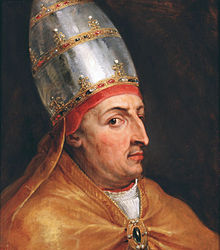
“We grant you [Kings of Spain and Portugal] by these present documents, with our Apostolic Authority, full and free permission to invade, search out, capture, and subjugate the Saracens and pagans and any other unbelievers and enemies of Christ wherever they may be, as well as their kingdoms, duchies, counties, principalities, and other property […] and to reduce their persons into perpetual servitude.”
These clearly refers to the lands along the coast of West Africa. By these decree, Pope Nicholas V conceded to the King of Portugal Afonso V and Prince Henry and all their successors, all their conquests of Africa, and reduction to perpetual servitude of all people deemed non-believers and enemies of Christ, and all their properties.
A significant subsequent concession given by Nicholas V in a brief issued to King Alfonso in 1454 extended the rights granted to existing territories to all those that might be taken in the future. Together with a second reference to some who have already been enslaved, this has been used to suggest that Nicholas sanctioned the purchase of black slaves from “the infidel”: “… many Guineamen and other negroes, taken by force, and some by barter of unprohibited articles, or by other lawful contract of purchase, have been … converted to the Catholic faith, and it is hoped, by the help of divine mercy, that if such progress be continued with them, either those peoples will be converted to the faith or at least the souls of many of them will be gained for Christ.”
This bull is currently conserved at the Institute of the National Archives of Torre do Tomba in Lisboa, Portugal, under the reference PT/TT/BUL/0007/29 and is fully translated to French in the book “le Péché du pape contre l’Afrique” (The Sin of the Pope against Africa) (éd. Al qalam, Paris, 2002) de Assani Fassassi, P. 10 – 21.
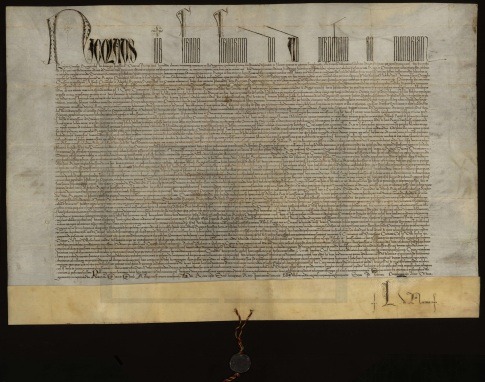
#catholics and slavery#pope nicholas v#dum diversas#Dum Diversas or The Vatican’s Authorization of Slavery#who started slavery of Africans#Enslaved Africans#catholic church is paying Reparations#Reparations
66 notes
·
View notes
Video
I put forth the medieval Papal Bull Dum Diversas for Universal Resending Pope Nicholas V issued the papal bull Dum Diversas on 18 June, 1452. It authorized Alfonso V of Portugal to reduce any “Saracens (Muslims) and pagans and any other unbelievers” to perpetual slavery. This kicked off the West African slave trade as well as the brutal theft and genocide of the Americas and the Doctrine of Discovery all of which continue today in some form or fashion. -Published on Mar 18, 2017 On this week’s On Contact, Chris Hedges discusses the rise of American imperialism with Stephen Kinzer, author of “The True Flag: Theodore Roosevelt, Mark Twain, and the Birth of American Empire”. RT Correspondent looks back to the beginning of America’s overseas expansion.
0 notes
Text
THE ESTABLISHMENT OF CHATTEL SLAVERY BY THE CATHOLIC POPE NICHOLAS V 6/18/1452
Papal Bull Dum Diversas 18 June, 1452
Permalink
Pope Nicholas V issued the papal bull Dum Diversas on 18 June, 1452. It authorised Alfonso V of Portugal to reduce any “Saracens (Muslims) and pagans and any other unbelievers” to perpetual slavery.
This facilitated the Portuguese slave trade from West Africa.
The same pope wrote the bull Romanus Pontifex on January 5, 1455 to the same Alfonso. As a follow-up to the Dum diversas, it extended to the Catholic nations of Europe dominion over discovered lands during the Age of Discovery. Along with sanctifying the seizure of non-Christian lands, it encouraged the enslavement of native, non-Christian peoples in Africa and the New World.
“We weighing all and singular the premises with due meditation, and noting that since we had formerly by other letters of ours granted among other things free and ample faculty to the aforesaid King Alfonso – to invade, search out, capture, vanquish, and subdue all Saracens and pagans whatsoever, and other enemies of Christ wheresoever placed, and the kingdoms, dukedoms, principalities, dominions, possessions, and all movable and immovable goods whatsoever held and possessed by them and to reduce their persons to perpetual slavery, and to apply and appropriate to himself and his successors the kingdoms, dukedoms, counties, principalities, dominions, possessions, and goods, and to convert them to his and their use and profit – by having secured the said faculty, the said King Alfonso, or, by his authority, the aforesaid infante, justly and lawfully has acquired and possessed, and doth possess, these islands, lands, harbors, and seas, and they do of right belong and pertain to the said King Alfonso and his successors”.
In 1493 Alexander VI issued the bull Inter Caetera stating one Christian nation did not have the right to establish dominion over lands previously dominated by another Christian nation, thus establishing the Law of Nations. Together, the Dum Diversas, the Romanus Pontifex and the Inter Caetera came to serve as the basis and justification for the Doctrine of Discovery, the global slave-trade of the 15th and 16th centuries, and the Age of Imperialism.
Dum Diversas (Latin Original).
Papal Bulls
SUGGESTED CITATION
Indigenous Values Initiative, "Dum Diversas," Doctrine of Discovery Project (23 July 2018), https://doctrineofdiscovery.org/dum-diversas/.
#THE ESTABLISHMENT OF CHATTEL SLAVERY BY THE CATHOLIC POPE NICHOLAS V 6/18/1452#THE START OF SLAVERY#Catholic Papal Bull establishing slavery#spain#portugal#italy#popes#catholic church slavery#Doctrine of Discovery#Age of Imperialism#Dum Diversas#Catholic Slavers
16 notes
·
View notes
Text
1452 Dum Diversas
youtube
Many of you have no idea of how slavery began and you don't understand that it is totally connected to Catholicism.
Watch this and learn
2 notes
·
View notes
Video
youtube
The UNTOLD Role From Catholic Church's In Slavery
#catholicism and slavery#The UNTOLD Role From Catholic Church's In Slavery#Africans enslaved by the catholic church#spain#portugal#pope nicholas v#dum diversas#who started slavery of Africans#white lies#white supremacy#the bible
12 notes
·
View notes
Text

Pope Nicholas V issued the Papal Bull Dum Diversas on 18 June, 1452. It authorised Alfonso V of Portugal to reduce any “Saracens (Muslims) and pagans and any other unbelievers” to perpetual slavery. This facilitated the Portuguese slave trade from West Africa.
The same pope wrote the bull Romanus Pontifex on January 5, 1455 to the same Alfonso. As a follow-up to the Dum diversas, it extended to the Catholic nations of Europe dominion over discovered lands during the Age of Discovery. Along with sanctifying the seizure of non-Christian lands, it encouraged the enslavement of native, non-Christian peoples in Africa and the New World.

In his book, Capitalism & Slavery, Eric Williams writes, “Portugal, which had initiated the movement of international expansion, claimed the new territories on the ground that they fell within the scope of a papal bull of 1455 authorizing her to servitude all infidel peoples. The two Powers (Portugal and Spain), to avoid controversy, sought arbitration and, as Catholics, turned to the Pope – a natural and logical step in an age when the universal claims of the Papacy were still unchallenged by individual governments.
After carefully sifting the rival claims, the Pope issued in 1493 a series of papal bulls which established a line of demarcation between the two states: the East went to Portugal and the West to Spain… England, France, and even Holland, began to challenge the Iberian Axis and claim their place in the sun. The Negro, too, was to have his place, though he did not ask for it: it was the broiling sun of the sugar, tobacco and cotton plantations of the new world.”
Pan-African Scholars discuss the role of the Catholic Church in the slave-trade:
It is important to understand that the majority of the men, women, and children that were sold to the Europeans during the trans-atlantic slave trade were the Biblical Israelites / Hebrews/ Jews.
Thus, the largest and most devastating coerced migration of all time fulfilled the the following biblical prophecy:
Deuteronomy 28:68 King James Version (KJV) 68 And the Lord shall bring thee into Egypt again with SHIPS, by the way whereof I spake unto thee, Thou shalt see it no more again: and there ye shall be sold unto your enemies for bondmen and bondwomen, and no man shall buy (redeem) you.
One may not understand why the God of Israel told the Israelites that they would be taken into Egypt again. It is simply because Egypt was the first place where the Israelites were in captivity. They were oppressed by the Egyptians for four hundred years according to the bible and history. Egypt simply represented bondage.
Hence:
Exodus 13:3 King James Version (KJV) 3 And Moses said unto the people, Remember this day, in which ye came out from Egypt, out of the house of bondage; for by strength of hand the Lord brought you out from this place
Exodus 1:11 King James Version (KJV) 11 Therefore they did set over them taskmasters to afflict them with their burdens. And they BUILT for Pharaoh TREASURE CITIES, Pithom and Raamses.
We must understand that black people are the only one’s that fit the historic conditions and curses of captivity, displacement, and oppression in time and space (Deuteronomy 28, Leviticus 26). This means that the true, biblical Israelites are a black people. Furthermore, this is why today people think that Africans sold their “own” people into slavery during the Trans-Atlantic slave trade. However, that is not biblically accurate.
Genesis 10 breaks down the “table of nations” and from this we understand, that Africans (Hamites) sold another nation, the black Israelites (Semites) into the hands of another nation, the Europeans (Japhetites). But since these black Israelites lost their identity and fled into Africa after 70 AD (discussed below), they were and still are categorized as “African”. This is no surprise, because people often say that “all black people look alike”.
This is true, because Israelites, like Joseph, Moses, and the apostle Paul got mistaken for Egyptians in the Old and New Testaments (e.g. Exodus 2:17-20, Acts 21:37-39). Once in Africa, the Israelites, with no homeland, were relegated to the lower echelons of African society and were more susceptible to being sold to the Europeans for guns, weapons, and other goods. Black people (Africans) selling other black people (Israelites) into slavery should not be a surprise, as it is no different to when the Egyptians enslaved the Israelites in times of old.
Thus, history has repeated itself! It was indeed the free labor and bitter bondage of the Israelites which made Egypt a super power as seen above. It is likely, that these Israelite slaves are the one’s that built the pyramids! The Lord said the Israelites would go into Egypt AGAIN “by way of ships” to be sold as “bondmen and bondwomen”.
So it should be to no surprise that the captives brought to these lands made the Americas a super power based on free labor and bitter bondage! These incredible prophetic events are a witness to us, that the God of the bible is the only true and living God, as he has told the end of all major world events, before the transpired (Isaiah 46:8-10).
We see that in the 1st century AD, Jesus – God manifested in the flesh (Philippians 2)- also foretold the captivity and dispersion of the biblical Jews, which would fulfill the (2500+ year old) prophecy, recorded in Deuteronomy 28, Leviticus 26 and Jeremiah 13:
Luke 21:24 King James Version (KJV) 24 And they (Jews) shall fall by the edge of the sword, and shall be LED AWAY CAPTIVE into ALL NATIONS: and Jerusalem shall be trodden down of the Gentiles, until the times of the Gentiles be fulfilled.
If you read Luke 21 in its entirety, you will see that “they” are referring to the three tribes (Judah, Benjamin, and Levi) known as Judah or Jews. According to Genesis 10, the Gentiles comprise of the offspring of Japheth, and today are know as “Europeans”. Jerusalem was “trodden down by the Gentiles” In 70 A.d. by the Roman emperor Titus and his campaign, when he besieged the city. This is a well known documented fact.
These Gentiles, by way of the Balfour Declaration and United Nations, occupy Israel and are currently ruling the world as God has foretold (e.g. Daniel 7).
The Israelites, that were “led away captive” were the same ones that were shipped “into all nations” as prophesied in Deuteronomy 28:68. In the New World, they are known as “African-Americans.” Dr. Rudolph Windsor, scholar of African and Hebrew history, explains how these Israelites ended up in Africa before their coerced migration to the New World and abroad.
In his book From Babylon to Timbuktu, he writes:
‘In the year 65B.C. the Roman armies under General Pompey captured Jerusalem. In 70 A.D. General Vespasian and his son, Titus put an end to the Jewish state, with great slaughter. During the period of the military governors of Palestine, many outrages and atrocities were committed against the residue of the people. During the period of Pompey to Julius, it has been estimated that over 1,000,000 Jews (Israelites) fled into Africa, fleeing from Roman persecution and slavery. The slave markets were full of black Jewish slaves.’Millions of Israelites who escaped the persecution of the Roman-Jewish War fled into the interiors of Africa.
In his book Jewish Roots in Africa, Mr Litchtblau, speaking of the Israelites that ran into Africa, says this:
“Pressed under sweeping regional conflicts, Jews settled as traders and warriors in Yemen, the Horn of Africa, Egypt, the kingdom of Kush and Nubia, North African Punic settlements (Carthage and Velubilis), and areas now covered by Mauritania. More migrants followed these early Jewish settlers to Northern Africa…”
Rudolph Windsor in his book From Babylon to Timbuktu, p. 120, goes on to say :
“The black Jews who migrated to the Sudan from the North converged with the Jews migrating from the eastern Sudan to the countries of the Niger River…There is much proof, and still much more to be revealed by scholars, that there existed prior to the slave trade and subsequent to it many tribes, colonies, and kingdoms in West Africa’.
Taken from Rudolph Windsor’s book, “Judea Trembles Under Rome”
Approximately 1600 years later, the Israelites that were scattered into Africa were rounded up and captured by African and the Arabs slave traders and eventually sold to the Europeans to be shipped, objectified, and oppressed. These events fulfilled the curses that were written in Deuteronomy the 28th chapter!
The Europeans that are responsible for scattering the majority of the biblical Jews into the four corners of the earth are the Gentiles. Their rulership was prophesied of in Daniel 7. However, this rulership will come to an end at the second coming of the Lord. It is only once the Lord RETURNS, will he regather the children of Israel from the present bondage that they are in, all over the world:
The prophets of God and Jesus himself have told us about this regathering and relief of oppression for the scattered Israelites:
Joel 3:1-3,6-7,15-17 King James Version (KJV) 1 For, behold, in those days, and in that time, when I shall bring again (return/remove) the captivity of Judah and Jerusalem,
2 I will also gather all nations, and will bring them down into the valley of Jehoshaphat (Armageddon), and will plead with them there for my people and for my heritage Israel, whom they have scattered among the nations, and parted my land.
3 And they have cast lots for my people; and have given a boy for an harlot, and sold a girl for wine, that they might drink.
6 The children also of Judah and the children of Jerusalem have ye sold unto the Grecians, that ye might remove them far from their border.
7 Behold, I will raise them out of the place whither ye have sold them, and will return your recompence upon your own head:
16 The Lord also shall roar out of Zion, and utter his voice from Jerusalem; and the heavens and the earth shall shake: but the Lord will be the hope of his people, and the strength of the children of Israel.
15 The sun and the moon shall be darkened, and the stars shall withdraw their shining.
17 So shall ye know that I am the Lord your God dwelling in Zion, my holy mountain: then shall Jerusalem be holy, and there shall no strangers pass through her any more.
Jesus told us about the same thing:
Matthew 24:29-31
King James Version (KJV)
29 Immediately after the tribulation of those days shall the sun be darkened, and the moon shall not give her light, and the stars shall fall from heaven, and the powers of the heavens shall be shaken:
30 And then shall appear the sign of the Son of man in heaven: and then shall all the tribes of the earth mourn, and they shall see the Son of man coming in the clouds of heaven with power and great glory.
31 And he shall send his angels with a great sound of a trumpet, and they shall gather together his ELECT from the four winds, from one end of heaven to the other.
Who are the Lords’s ELECT?
Isaiah 45:4
King James Version (KJV)
4 For Jacob my servant’s sake, and Israel mine ELECT, I have even called thee by thy name: I have surnamed thee, though thou hast not known me.
These Israelites are still scattered in the four corners of the earth and will remain dispersed until the Lord returns to regather them. These Israelites, scattered in the four corners of the earth, are now currently experiencing the worst forms of socioeconomic oppression in all their lands of captivity in fulfillment of prophecy.
They are also an astonishment to the other nations around them, and will continue to be oppressed and confined to the bottom rung of society until they return to their true identity and worship of their God. This is why it is important for the Israelites to know their history and understand that God is the one that orchestrated their enslavement because they broke the “everlasting covenant” (Deuteronomy 28). Ultimately, God is in control of their captivity, and we must understand that God allowed the pope to authorize their enslavement.
Therefore, no one, especially Israelites should “hate” or blame the “white man”, for their oppression, because the wicked will get their just reward.
Rather Israelites (and all who desire eternal life), need to find out about their history and realize why God allowed this to happen, and turn back to the true and living God, who has called the end from the beginning, by keeping his commandments through faith.
* Bibliographic Reference: This English translation of Romanus Pontifex is a reproduction of its publication in European Treaties bearing on the History of the United Statesand its Dependencies to 1648, Frances Gardiner Davenport, editor, Carnegie Institution of Washington, 1917, Washington, D.C., at pp. 20-26. The original text in Latin is in the same volume, at pp. 13-20.
#THE POPE#THE JEWS#AND THE SLAVE TRADE#catholicism and slavery#dum diversas#king james#king james bible#Africans stolen by the catholic church#white lies#religious lies#white supremacy#hate crimes
6 notes
·
View notes
Text
In a brilliant essay, “Decolonial Theology and Changing the Global Church” on the Berkley Forum, Dr. Debora Tonelli says that “At the end of official colonialism, religion has often been the space in which colonized people have fought to build their new identity.” With regard to Indigenous nations and peoples, I would suggest a slight modification of that concept: “...the religion of the invaders has often been the space in which dominated and colonized peoples, those who have survived the intergenerational onslaught, have fought to build a new identity under an imposed system of domination.
My inspiration for that modification comes from a number of Vatican papal decrees issued by various popes during the fifteenth century (1436, 1452, 1454, 1455, 1456, 1481, 1493, 1506, and 1514). The Latin language of those documents is quite useful. It provides insight into the church-state coalition that served as an engine, so to speak, for establishing a system of domination over distant non-Christian lands during the so-called Age of Discovery.
Are the Papal Bulls Political Documents of Christian Empire?
While present-day Catholic Church experts tend to say that the language of those papal bulls is not part of official Church teaching, this is beside the point. Years ago, in 1992, Bishop (now Archbishop) Charles J. Chaput told me that the papal bulls I was referring to were “political documents.” I think he meant that they are not based on and do not express official church teachings.
I understand his use of the phrase “political documents” to mean that those papal decrees expressed the political intention of the popes of the Holy See, an intention to extend the system of domination of Western Christendom to distant lands in a spirit of “Christian empire” (Christiani imperii, in the Latin language of the bulls). This was to be accomplished by “reducing the barbarous nations” (ac barbarae nationes deprimantur) to subjection or domination.
The more egregious political language of those documents, going back to the Dum Diversas of 1452, expressed the directive to “invade, capture, vanquish, and subdue” non-Christians; “reduce their persons to perpetual slavery”; “take away all their possessions and property”; and “convert” the land, meaning to unlawfully or wrongfully take away that which belongs to another.
That kind of language provides us with the insight into what happens when free and independent nations and peoples have been invaded and deadly colonial patterns have been brutally imposed on them for generations, in the name of “the state” and Jesus. A resulting system of domination will then become “the space” within which Dr. Tonelli says that colonized people have fought to build “a new identity,” and within which they will perhaps “struggle for independence.”
However, this “new” identity will be a “colonized” rather than a liberated one. The colonized will then be working toward a form of independence under and subject to the imposed Christian European system of domination. Curiously, Dr. Tonelli’s account does not envision dominated (colonized) nations and peoples working to restore their original free and independent existence, by liberating themselves from the imposed system of Christian empire and domination.
Dominorum Christianorum: Christian Dominators
During a 2016 meeting with the Pontifical Council for Justice and Peace, I said to Archbishop Silvano Tomasi, “With respect, I believe there is much of your own history you don’t know. Let me ask you, have you ever actually read the papal bulls” from the fifteenth century? He replied, “No, I must confess.” The point being that most Catholics and even some of the highest Church officials have never studied the Latin language of those Church documents, and certainly not from an Original Nations or Indigenous peoples’ perspective.
A book published by the U.S. Library of Congress, just a few years ago, contains replicas of the papal bull of September 26, 1493, the Dudum Siquidem. That line is taken from the middle of the papal bull dated May 3, 1493, “que sub dominio actuali temporali aliquorum dominorum Christianorum constitute non essent.” This refers to lands discovered and to be discovered in the future “that were not established under the domination of any Christian dominators.”
Whether the intent of domination expressed by that language is part of “official Church teachings” is irrelevant in my view. What is relevant is that, throughout the world, the present-day context and conditions experienced by “Indigenous” nations and peoples is an outgrowth of the patterns of domination and dehumanization expressed in those many documents issued centuries ago by the Holy See.
In State of the World’s Indigenous People (2009), published by the Economic and Social Council of the United Nations, there is section titled “The Concept of Indigenous Peoples.” After saying that no specific definition has been “adopted by any United Nations-system body,” an example of a “working definition” is provided. It refers to “Indigenous communities, peoples and nations” which have “a historical continuity with pre-invasion and pre-colonial societies that developed on their territories.” Terms such as “pre-invasion” and “pre-colonial” suggests a post-invasion and post-colonial period, or, in other words, after the claim of a right of domination has been asserted and maintained.
Furthermore, the international working definition says that Indigenous peoples “consider themselves distinct from other sectors of the societies now prevailing on those territories, or parts of them,” which means “now dominating.” It also says that Indigenous communities, peoples, and nations “form at present non-dominant sectors of society...” The opposite of the non-dominant is the dominant, or the dominating states, which are the non-Indigenous. Despite these clear connections, the UN working definition never uses the word domination. Nor does it focus on the fact that the phrase “Indigenous peoples” is accurately interpreted as meaning “dominated peoples.”
Here’s one thing the Vatican papal bulls are able to teach us: Over a period of more than five centuries, a system of domination (the dominio of the dominorum Christianorum) was globalized by means of the language patterns found in the Vatican papal bulls of the fifteenth century.
That system now serves as the linguistic and behavioral “space” in which colonized Indigenous peoples, without being aware of it, have been working to build an identity as dominated peoples within the framework of the United Nations, which is an organization of “states” of domination. The question arises: How do we end the global system of domination and its devastating effects on the planet?
#What Fifteenth-Century Papal Bulls Can Teach Us About Indigenous Identity#white lies#catholic popes#who started slavery#catholic church#catholic pope nicholas v started slavery#nicholas v#dum diversas#Africans stolen for white lies#Africans enslaved for the catholics#Reparations#Reparations are due
3 notes
·
View notes